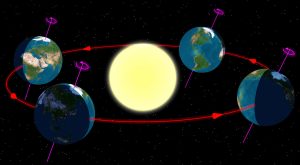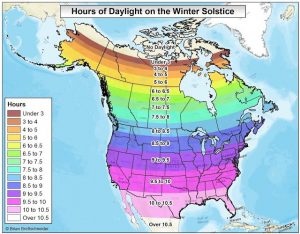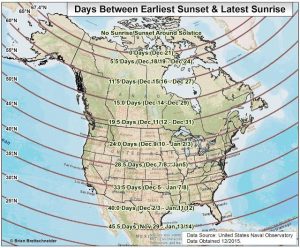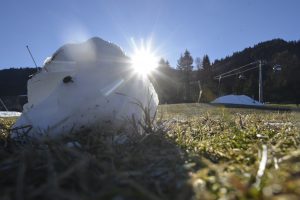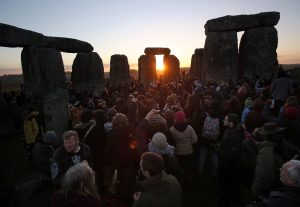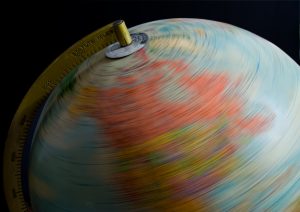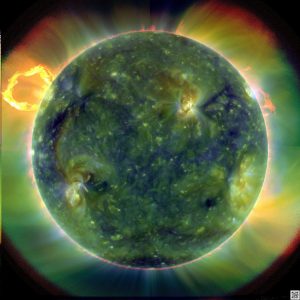Winter solstice (or hibernal solstice) is an astronomical phenomenon marking the shortest day and the longest night of the year. In the Northern Hemisphere this is the December solstice and in the Southern Hemisphere this is the June solstice.
The axial tilt of Earth and gyroscopic effects of its daily rotation mean that the two opposite points in the sky to which the Earth’s axis of rotation points (axial precession) change very slowly (making a complete circle approximately every 26,000 years). As the Earth follows its orbit around the Sun, the polar hemisphere that faced away from the Sun, experiencing winter, will, in half a year, face towards the Sun and experience summer. This is because the two hemispheres face opposite directions along Earth’s axis, and so as one polar hemisphere experiences winter, the other experiences summer. The winter solstice is considered by some to mark the end of autumn and the start of winter.
More evident from high latitudes, a hemisphere’s winter solstice occurs on the shortest day and longest night of the year, when the sun’s daily maximum elevation in the sky is at its lowest. The winter solstice itself lasts only a moment in time, so other terms are used for the day on which it occurs, such as “midwinter”, or the “shortest day”. It is often considered the “extreme of winter” (Dongzhi in the Chinese calendar). In meteorology, winter in the Northern Hemisphere spans the entire period of December through February. The seasonal significance of the winter solstice is in the reversal of the gradual lengthening of nights and shortening of days. The earliest sunset and latest sunrise dates differ from winter solstice, however, and these depend on latitude, due to the variation in the solar day throughout the year caused by the Earth’s elliptical orbit (see earliest and latest sunrise and sunset).
Worldwide, interpretation of the event has varied across cultures, but many have held a recognition of rebirth, involving holidays, festivals, gatherings, rituals or other celebrations around that time.
The winter solstice is upon us: Wednesday, December 21, 2016, will be the shortest day and longest night of 2016 for anyone living north of the equator. If pagan rituals are your thing, this is no doubt a big moment for you. If not, the official first day of winter is neat for other reasons, too.
Below is a short scientific guide to the longest night of the year (though not, as we’ll see, the longest night in Earth’s history — that happened back in 1912).
Why do we have a winter solstice, anyway?
Most people know this one. Earth orbits around the sun on a tilted axis (likely because our planet collided with some other massive object billions of years ago, back when it was still being formed).
So between September and March, Earth’s Northern Hemisphere gets less exposure to direct sunlight over the course of a day. The rest of the year, the north gets more direct sunlight and the Southern Hemisphere gets less. It’s the reason for the seasons:
In the Northern Hemisphere, “peak” sunlight usually occurs on June 20, 21, or 22 of any given year. That’s the summer solstice. By contrast, the Southern Hemisphere reaches peak sunlight on December 21, 22, or 23 and the north hits peak darkness — that’s our winter solstice.
Technically speaking, the winter solstice occurs when the sun is directly overhead the Tropic of Capricorn, or 23.5° south latitude. Like so: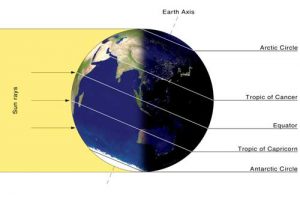
In 2016, this will occur at exactly 5:54 am EST on December 21.
How many hours of sunlight will I get on Wednesday?
That depends on where you live. The further north you are, the less sunlight you’ll get during the solstice — and the longer the night will be.
Washington DC will get about 9.5 hours of daylight — and 14.5 hours of glorious, glorious darkness.
On the off chance you live near the Arctic Circle, you’ll barely get any daylight during the solstice (if you live north of the circle, you’ll get none). The time lapse below shows the eerie scene in Fairbanks, Alaska, which only gets three hours of sunlight on the solstice — the sun basically skims the horizon for a a brief while and then vanishes:
Is the solstice the earliest sunset of the year?
Not usually. Just because December 21 is the shortest day of the year for the Northern Hemisphere, it doesn’t mean every location has its earliest sunset or latest sunrise on that day.
This map showing earliest sunset/latest sunrise for different parts of North America:
If you live in Washington, DC, you missed the earliest sunset — it happened back on December 6. But you can still catch the latest sunrise on January 6. If you like sleeping in, that’s arguably the most exciting day of the winter. No annoying sun bothering you in the morning.
Is the winter solstice the coldest day of the year?
Also not usually! It’s true that the Northern Hemisphere gets the least direct sunlight on the winter solstice (which is officially the first day of winter). But the coldest months are yet to come — usually in January or February, depending on where you live.
A big reason for this “seasonal lag” is that the Earth’s massive oceans absorb much of the sun’s energy and release it slowly, over time. So there’s a delay between when there’s the least sun and when the air temperatures are actually coldest. The same thing happens in summer — there’s a delay between when solar insolation is at its maximum (the summer solstice in June) and when the hottest months are (usually July or August).
This seasonal lag varies greatly from place to place — during the summer, it’s pretty extreme in San Francisco, which is surrounded by water on three sides, and where temperatures don’t typically peak until September. Likewise, places distant from large bodies of water, like Iowa, can often see sharper swings in temperature than places like Rome that are surrounded by ocean.
5) What does all this have to do with Stonehenge?
No one knows for sure why Stonehenge was built some 5,000 years ago (at least I don’t, sorry). But one strong possibility is that it was used to mark solstices and equinoxes. That’s because the structure is directly aligned toward the sunset during the winter solstice. (The sun also rises directly over the Heel Stone during the summer solstice.)
Why was the winter solstice a big deal? Here’s Teresa Wilson of the American Astronomical Society to explain: “While the summer solstice draws a larger crowd, the winter solstice may have been more important to the ancient builders. At this time, cattle were slaughtered so the animals did not need to be fed through the winter, and wine and beer made previously had finally fermented.”
Nowadays, humans still gather to pay homage the winter solstice at Stonehenge — they just use modern technology, like so:
Is Wednesday the longest night in Earth’s entire history?
Probably not, although it’s close. And the reason why is quite interesting.
Ever since the Earth has had liquid oceans and a moon, its rotation has been gradually slowing over time due to tidal friction. That means — over very, very long periods of time — the days have been getting steadily longer. About 4.5 billion years ago, it took the Earth just six hours to complete one rotation. About 350 million years ago, it took 23 hours. Today, of course, it takes about 24 hours. And the days will gradually get longer still.
Given that, you’d think the winter solstice of 2016 would be the longest night in all of history. But while it’s certainly up there, it doesn’t quite take top honors.
That’s because tidal friction isn’t the only thing affecting the Earth’s rotation — there are a few countervailing factors. The melting of glacial ice, which has been occurring since the end of the last Ice Age 12,000 years ago (and is now ramping up because of global warming) is actually speeding up Earth’s rotation very slightly, shortening the days by a few fractions of a millisecond. Likewise, geologic activity in the Earth’s core, earthquakes, ocean currents, and seasonal wind changes can also speed up or slow down the planet’s rotation.
When you put all these factors together, scientists have estimated that the longest day in Earth’s history (so far) likely occurred back in 1912. That year’s summer solstice was the longest period of daylight the Northern Hemisphere has ever seen. And, conversely, the 1912 winter solstice was the longest night we’ve ever seen.
Eventually, the effects of tidal friction should overcome all those other factors and Earth’s days will get longer and longer as its rotation keeps slowing (forcing timekeepers to add leap seconds to the calendar periodically). Which means that in the future, there will be plenty of winter solstices that set new records as the “longest night in Earth’s history.”
The image above was taken by NASA’s Solar Dynamics Observatory, a spacecraft launched in 2010 to better understand the sun. Caption: “A full-disk multiwavelength extreme ultraviolet image of the sun taken March 30, 2010. False colors trace different gas temperatures. Reds are relatively cool (about 60,000 Kelvin, or 107,540 F); blues and greens are hotter (greater than 1 million Kelvin, or 1,799,540 F).”
Did you know that if you subscribe to our website, you will receive email notifications whenever content changes or new content is added.
1. Enter your e-mail address below and click the Sign Me Up button.
2. You will receive an email asking you to confirm your intention of subscribing to our site.
3. Click the link in the email to confirm. That’s all there is to it! Note: if you wish to unsubscribe from our site, click the unsubscribe link at the bottom of the email you received.
Then indicate you no longer wish to receive our emails.
Thank You
Dialect Zone International
